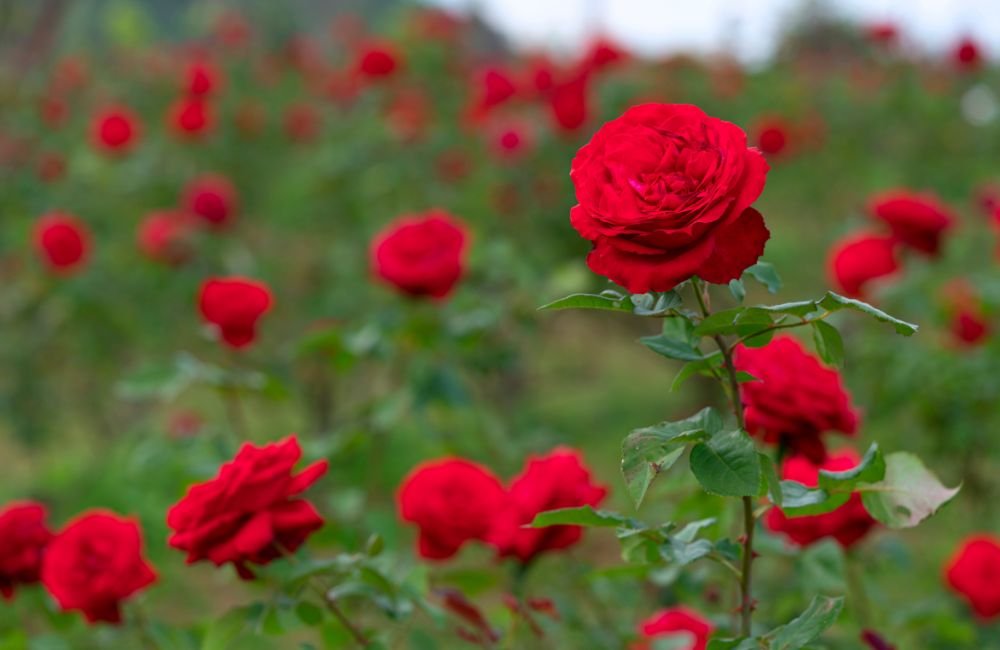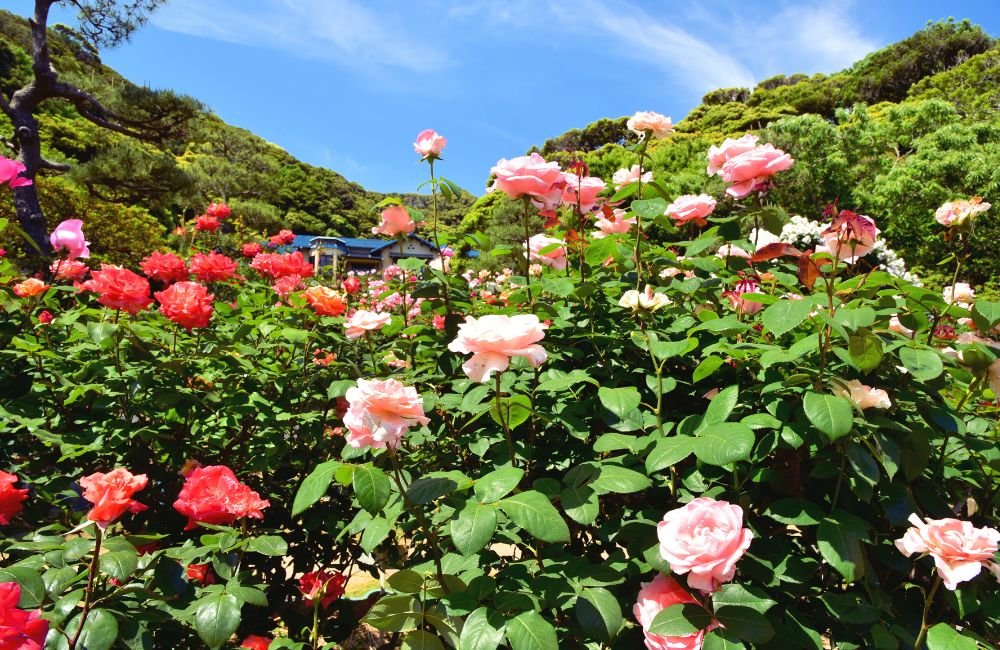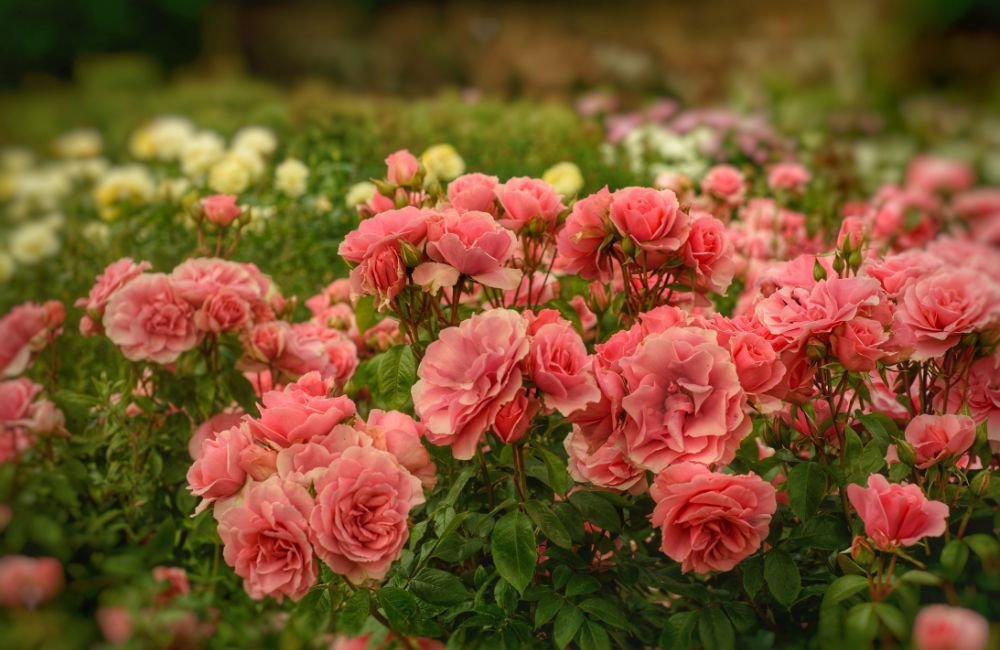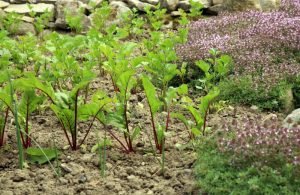Roses look intimidating, but you can master them with a simple plan. Soil, sun, and water set the foundation for strong canes and repeat blooms. Pruning by class keeps shrubs tidy and productive. Smart pest and disease prevention saves time and money. This guide shows you how to grow roses with clear steps you can use in any U.S. climate.
How to Grow Roses
Roses reward patient simple care. You need the right type, good sun, and steady water. This guide covers planting, pruning, feeding, and fixes so your shrubs bloom across U.S. zones. Here is how to grow roses at home:
Choose the Right Rose Type for Your Zone
Match varieties to climate and maintenance goals. Cold regions do well with hardy rugosas and own-root shrubs that rebound after winter dieback. Warm zones suit heat-tolerant floribundas and landscape shrubs that flower repeatedly. Hybrid teas deliver classic blooms but ask for more pruning and disease vigilance. Check black spot and mildew resistance, fragrance, mature size, and whether the plant is grafted or own-root before you buy.

Sun, Airflow, and Spacing Basics
Give roses six to eight hours of direct sun, with morning light to dry leaves quickly. Space plants so foliage doesn’t overlap when mature. Air moving between shrubs lowers disease pressure and keeps dew from lingering. Position beds where prevailing breezes pass through. Keep roses a bit off fences and walls to avoid heat build-up. Water at the base to keep foliage dry.
Soil pH, Drainage, and Organic Matter
Aim for slightly acidic soil, roughly pH 6.0 to 6.8. Do a quick percolation test to confirm drainage and use raised beds if water lingers. Blend in compost and aged bark to add structure and biology. Heavy clay benefits from coarse organic matter that opens pore space. Sandy soils need more organic matter to hold moisture and nutrients. Mulch after planting to moderate temperature swings.
Bare-Root vs Potted Plants
Bare-root roses are budget-friendly and establish fast when planted during dormancy. Rehydrate roots before planting and trim damaged tips. Potted roses offer flexible timing and visible structure, so you see what you’re getting. Set graft unions appropriately for climate. Cooler regions bury the union one to two inches. Warm regions keep it near the surface to prevent rot and encourage sturdy growth.
Planting Windows by Region
Cool and cold zones plant bare-root in early spring as soil thaws. Mild-winter areas often plant in fall so roots grow before summer heat. Container roses can go in almost any season if you avoid heat spikes and deep freezes. Prioritize soil prep and post-plant watering over calendar dates. Local frost dates and heat waves should guide final timing more than any single month.
Step-By-Step Planting and Watering In
Set plants up to root fast and avoid early stress. You’re creating a firm anchor, perfect depth, and an even moisture profile that encourages deep roots and steady new growth.
- Soak bare-root roses 4–12 hours. Water potted roses thoroughly before planting.
- Dig a hole twice as wide as the root mass, with roughened sides for root penetration.
- Build a small soil mound in the center so roots drape evenly.
- Set depth so the graft union is right for your zone, then backfill halfway and firm gently.
- Water to settle soil, finish backfill, and water again to remove air pockets.
- Form a shallow basin to hold irrigation and mulch two to three inches, keeping mulch off canes.
- Stake climbers to their support and provide light shade the first week if conditions are hot.
Hybrid Teas and Grandifloras
Prune in late winter or very early spring. Keep three to five strong canes and shorten to healthy outward buds. Remove dead, damaged, and crossing wood to open the center. Deadhead to an outward-facing bud on a strong stem to prompt repeat flushes. Feed consistently and monitor for black spot and mildew. Good airflow and clean cuts keep these high-performance classes blooming well.
Floribundas and Shrub Roses
These classes favor shape and density over long exhibition stems. Thin lightly to open the plant, then shorten branch tips to maintain a rounded habit. Many modern shrubs are self-cleaning, so deadheading is optional but tidy. Use renewal cuts on the oldest canes each year to keep vigor high. Their disease resistance and continuous bloom make them excellent hedges and mass plantings.
Climbers and Ramblers
Train main canes along supports as close to horizontal as possible to stimulate flowering along laterals. Tie with soft ties that won’t cut bark. Once-blooming ramblers get major pruning after flowering. Repeat-blooming climbers receive structural work in late winter and light shaping after flushes. Avoid removing young main canes in the first years. Focus on guiding growth and creating layers.

Deep Soaks and Mulch Strategy
Water deeply and less often so moisture reaches the full root zone. One to two inches weekly is a good starting point, adjusted for heat, wind, and soil texture. Drip or soaker lines keep foliage dry. Mulch two to three inches with shredded leaves or wood chips to reduce weeds and evaporation. Keep mulch off canes. Refresh annually to maintain a steady soil environment.
Fertilizer Timing Through the Season
Start feeding after leaf-out with a balanced or rose-specific fertilizer. Lightly reapply after the first bloom flush to support repeat flowering. Stop fertilizer six to eight weeks before expected frost to prevent tender growth. Use soil tests to correct deficiencies rather than guessing. Organic slow-release blends and compost teas support steady nutrition. Foliar feeds are optional boosters, not a replacement for soil health.
Container Roses Care Notes
Pick a 15–20 inch pot with large drainage holes and a high-quality potting mix. Water more often than in ground because containers heat and dry faster. Use slow-release fertilizer and occasional liquid feeds during peak growth. Choose compact shrubs, floribundas, or patio climbers bred for pots. Shift to a sheltered spot for winter in cold regions. Repot every two to three years to refresh media.
Pests and Diseases
Roses stay healthier when you prevent problems before they start. Focus on airflow, clean leaves, and fast diagnosis. Use gentle controls first, then escalate only when damage threatens buds and canes.
- Inspect plants every week and check new tips, leaf undersides, and buds. Catch outbreaks early to stop spread.
- Water at the base in the morning for steady uptake. Keep foliage dry to limit black spot and mildew.
- Prune for airflow to dry leaves faster and reduce disease. Remove crossing shoots and thin dense centers.
- Prioritize sanitation to break disease cycles. Remove fallen leaves and spent blooms, and bag infected debris.
- Mulch two to three inches around each plant. This reduces soil splash that spreads fungal spores.
- Target black spot, mildew, and rust with potassium bicarbonate, sulfur, or horticultural oil as labeled. Rotate products to prevent resistance and improve results.
- Go easy on nitrogen during fast growth. Lush, tender shoots invite pests and disease.
- Knock back aphids, whiteflies, and thrips with a strong water blast. Follow with insecticidal soap or neem oil and repeat until control holds.
- For Japanese beetles and rose sawflies, hand-pick into soapy water at dawn. Use neem or spinosad when pressure is heavy, and skip pheromone traps near the bed.
- Encourage beneficial allies to raise natural control. Plant dill, alyssum, and yarrow to attract lady beetles, lacewings, and parasitic wasps.
- If buds show webbing, check for budworms and prune out infested tips. Treat small larvae with Bacillus thuringiensis var. kurstaki as directed.
- Prevent cane borers by sealing fresh pruning cuts with white glue. If dieback appears, cut back to healthy pith and disinfect your tools.
- Do a winter reset after leaves drop. Apply dormant oil on bare canes to smother overwintering pests and eggs.
- Choose resistant cultivars for fewer sprays and easier care. Prioritize modern shrubs rated high for disease resistance in your zone.
- Keep simple records so patterns become clear. Note dates, weather, and treatments to refine your program.

Conclusion
Knowing how to grow roses gets easy when you match variety to your zone and prep the site well. Plant at the right depth, water deeply, and mulch to hold moisture. Prune by class to shape canes and spark repeat blooms. Stay ahead of pests with weekly checks, clean foliage, and gentle controls first. Keep notes, adjust to heat or cold, and you’ll enjoy confident color season after season.
When you want to propagate roses, check out this gardening guide!
FAQ: How to Grow Roses
- Can roses thrive in partial shade?
- Yes, with smart choices. Aim for four to six hours of sun, ideally morning light. Pick shade-tolerant groups like hybrid musks and some English shrubs. Expect fewer blooms and watch disease pressure closely.
- What is Rose Rosette Disease and what should I do if I see it?
- RRD is a virus spread by tiny eriophyid mites. Look for witches’ broom growth, red distorted shoots, and excessive thorns. Remove the entire plant and roots, bag it, and discard. Clean tools and replant with distance and airflow.
- Why are my leaves yellow with green veins?
- That’s classic iron chlorosis from high pH or alkaline irrigation. Use an EDDHA iron chelate for a fast fix. Lower soil pH gradually with elemental sulfur and improve drainage. Mulch to steady moisture and root health.
- How do I protect roses through severe winters?
- Stop fertilizing six to eight weeks before first frost and let the last blooms form hips. Mound 8–12 inches of soil or compost over the crown. Add a wire cage and dry leaves, then wrap a burlap wind screen. Uncover gradually in spring and prune when buds swell.
- Do banana peels, coffee grounds, or Epsom salt actually help?
- Use only if a soil test says you need it. Magnesium sulfate helps roses low in magnesium, not every plant. Compost coffee grounds and peels first for safer, balanced nutrition. Blind additives can unbalance pH and invite pests.






